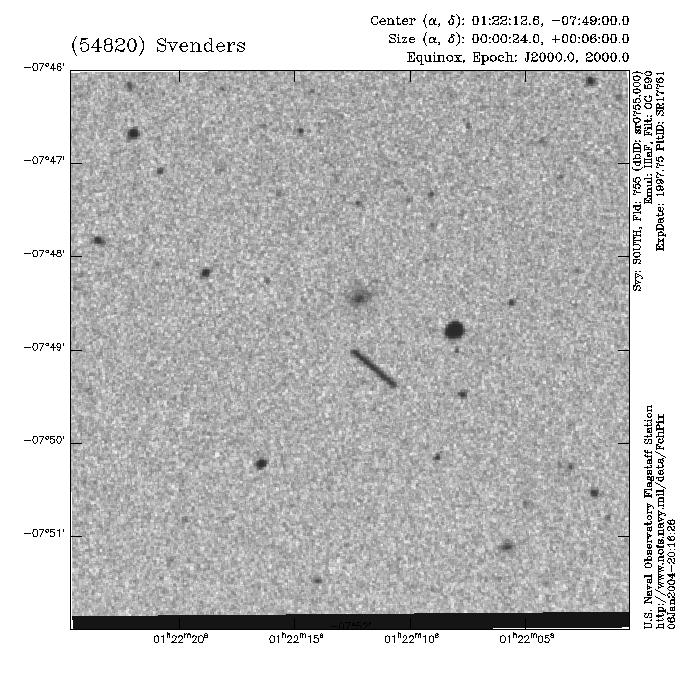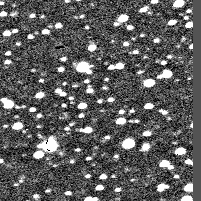

Here is the discovery image of asteroid "Svenders", taken on the evening of Tuesday, July 10, 2001 (July 11 universal time) from the George Observatory, a Houston Museum of Natural Science satellite facility located inside Brazos Bend State Park. I have aligned the stacks and then cropped out an area of 201x201 pixels centered on the object, padding as necessary so that all the images are the same size. As you can see, we were having some pretty bad problems with our tracking that night! The asteroid was attempting to escape out the right edge of our field of view as we were shooting, and nearly made it. I processed the data the next day, and once I found out that the brightest object in the field was in fact an unknown, I hit the panic button... objects that bright don't remain undiscovered for very long! It generally takes a pair of nights to get credit for discovering an object, so we called out to the observatory and Louis Binder of the Supernova discovery team kindly shot the asteroid for us the next night. We got the data turned into the minor planet center at record speed, and were rewarded with credit for discovering a new object. The minor planet center assigned the provisional name 2001 NV1 to the object.
Objects as bright as 2001 NV1 generally have been observed before. The only question was, when our new discovery was found to link back to older observations, which set of observations would get the credit as being the "official discovery"? We observed 2001 NV1 twice more, improving the orbital fit, and after about 10 days of observation it linked back to observations from 1999 and 2000... but our data fit the combined orbit better than the earlier data, and we kept credit.
It generally takes at least 4 years' worth of data before an object's orbit is considered to be so well known that it won't ever get lost again. Once that happens, an official number is assigned, and the discoverers may propose a name. For bright asteroids, it is often possible to find old images on sky survey plates, and that was indeed the case for 2001 NV1. Courtesy of the archival data, 2001 NV1 was able to jump the queue and was numbered in 2002.

Here asteroid Svenders was accidentally caught wandering through a sky-survey image taken on September 30, 1997. The length of the exposure is 1 hour. Precovery image found by Andrew Lowe.
Svenders was discovered by Geophysicists Bill Dillon and myself, Joe Dellinger. Both of us had worked at the Amoco Tulsa Research Center in the past, Bill for a summer in the mid-1980's, and Joe from 1994 until the end of Amoco in early 1999. Bill had worked with Sven Treitel while there, and thought it would be nice to name an asteroid for him. Joe knew Sven through activities involving the Society of Exploration Geophysics, in which Sven was quite active, and from reading Sven's classic papers from the 1960's and 70's, and agreed that was an excellent idea.
If there was to be an asteroid "Treitel", it only seemed fair to also name one "Robinson" for Sven's perennial academic co-author, Enders Robinson. However, there was already an asteroid named for an entirely different "Robinson". Since "Robinson and Treitel" was such a famous author pair, it seemed only fair that they should share a joint asteroid. Bill came up with the combined name "Svenders". Rumor has it that the astronomers who have to approve all asteroid names are more likely to approve clever combined names than they are names for single individuals, especially when the individuals being honored are non-astronomers.
(54820) Svenders = 2001 NV1
Discovered 2001 July 11 by Joe Dellinger and William G. Dillon at
the George Observatory, Brazos Bend State Park, Needville, Texas.
Named in honor of Enders Robinson (1930- ) and Sven Treitel (1929- ).
In 1952, Robinson became the first to ever perform signal processing on a
general-purpose digital computer. Robinson and Treitel later co-authored a
landmark series of papers that founded the modern field of applied geophysical
signal analysis.
Here is an orbital animation of Svenders. As you can see, Svenders is at its brightest when Earth passes it on the inside track in August or September. At discovery on July 11, 2001, Svenders was about magnitude 17.0, and remains the brightest asteroid I have yet discovered out of the 150 or so to my credit.